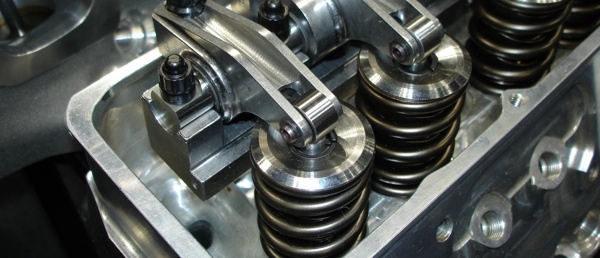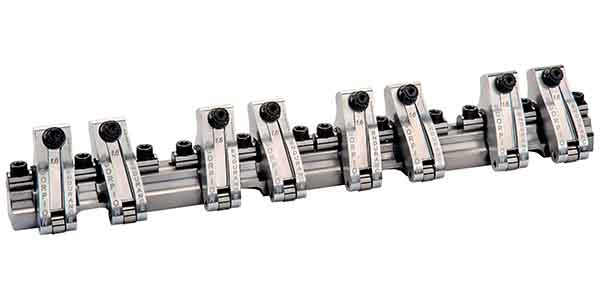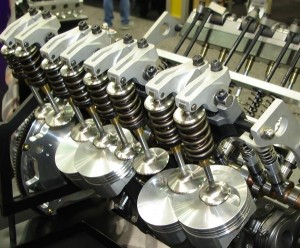
Everybody knows you need the right combination of valvetrain components to maximize an engine’s power potential. The trick is figuring out which components are the “right” ones for a given application. A high revving engine with an aggressive cam needs lightweight rocker arms and stiffer valve springs to keep up with the cam. If the springs are not strong enough, the valves will float or bounce — or possibly even hit the pistons. But if the springs are too stiff, they may bend the pushrods, overload the rocker arms or kill the camshaft.
Reducing the overall weight of the upper valvetrain components reduces the spring pressure needed to control the valvetrain. Reducing weight on the valve side of the rocker arm with lighter valves (undersized stems, hollow stems or titanium), lighter retainers and/or “beehive” springs (smaller diameter at the top reduced weight) are all modifications that can reduce the amount of valve spring pressure needed for a specific RPM range.
On the pushrod side of the rockers, however, strength is more important than weight. Stock pushrods are notoriously weak and tend to bend a flex quite a bit. Increasing the wall thickness of the pushrods, and/or using larger diameter pushrods adds some weight to the valvetrain, but more importantly it increases strength and rigidity significantly. And the stiffer the pushrods, the better the valvetrain dynamics.
When a pushrod flexes, it has a “pole vault” effect when the lifter passes over the top of the cam lobe. Although the cam has reached maximum lift and has stopped pushing the lifter up, the stored energy in the deflected pushrod snaps back and continues pushing the rocker arm and valve a little more. This pole vault effect effectively increases lift a bit and may actually help increase airflow at peak left. But the deflection that the pushrod undergoes while the valve is opening has a detrimental effect on cam duration and overall power. According to one major camshaft supplier, pushrod deflection can reduce cam duration as much as 20 degrees at higher engine speeds causing a measurable loss of power. Even at lower RPMs, pushrod deflection may reduce cam duration 5 to 10 degrees.
Pushrod deflection can also induce valvetrain harmonics and erratic motions that hurt performance. The engine may hit a certain RPM where power suddenly takes a dip. No amount of fuel or ignition timing will smooth it out because the power loss is being caused by unwanted valvetrain motions and harmonics.
Stiffening up the pushrods can help regain the lost power while reducing the risk of bending one or more pushrods. As some engine builders have discovered, increasing the stiffness of the pushrods has allowed them to use more aggressive cam profiles with more lift and/or duration.
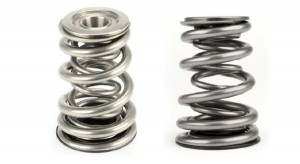
Valve Springs
The valve springs play a key role in controlling valvetrain motions and harmonics. Stiffer springs may seem like a no-brainer solution to keeping the valvetrain under control, but you don’t have to go overboard. The best advice is to use the smallest spring that can maintain valve control within the engine’s RPM range. Heavier springs increase friction and resistance as well as the load on the rockers, pushrods, lifters and cam lobes. The springs have to be stiff enough to keep the lifters in contact with the cam lobes, to pull the valves shut quickly enough at high RPM to prevent valve float, and to prevent the valves from bouncing when they close, but no stiffer than that. In other words, the springs have to match the profile of the cam, the weight of the valvetrain components and the RPM range of the engine.
For example, a small block street performance engine with a flat tappet cam and .450 inches of lift can usually get by with single springs and 80 to 90 lbs. of seat pressure. For a higher revving street/strip performance engine with a flat tappet cam, single springs with 100 to 120 lbs. of seat will usually do just fine. If we’re talking a street performance hydraulic roller cam, single springs with closed seat pressure of 105 to 140 lbs. might be required.
On late model Chevy LS engines, the stock valve springs only have 105 lbs. of seat pressure when closed, and 290 to 300 lbs. open. Many ProStock drag motors, by comparison, run double or triple springs with closed seat pressures of 400 to 500 lbs., and open pressures in the 1350 to 1450 lb. range. They need this kind of pressure to handle 9,000 to 10,000 RPM engine speeds with relatively large valves and heavy valvetrains. But durability isn’t as important because the runs are short and they typically replace the springs frequently.
NASCAR engines are also high revving engines, but in this type of racing durability is absolutely essential. Consequently most NASCAR teams are using relatively light springs (120 to 130 psi closed seat pressure) in their engines.
Beehive springs that have a reduced diameter in the top coils are used in some late model stock applications and are also a good upgrade over conventional valve springs in many applications. The advantage of the beehive spring is that it is less prone to harmonics and allows more RPMs with less spring tension. But beehive springs are only available as single springs. For higher RPM applications, a conventional dual spring or even triple spring is often required.
A little over a year ago, one camshaft manufacturer introduced a “conical” valve spring for improving valvetrain dynamics. The outside diameter of a conical spring gradually tapers to a smaller diameter from the bottom to the top like a cone. This shape reduces the overall weight and mass of the spring, and also changes the frequency at which the spring oscillates. The result is a lighter, less stiff valve spring that can rev higher and last longer than a conventional coil steel valve spring.
The conical spring design actually dates back to the early days of the automobile, but it never took off because the springs were difficult to manufacturer and didn’t offer much of a performance advantage in the low revving engines of that time period. Fast forward to today and the conical spring is now the latest thing in valvetrain technology. The springs are still tricky to manufacture but are considered a step up from beehive springs. The conical springs are given a special multi-step micropolish peening process for added durability. According to the manufacturer, they work best with hydraulic performance cams with .625 to .675 inch lift.
The latest innovation is a dual conical valve spring. Unlike conventional dual springs that rub against each other to provide dampening, the inner and outer conical springs are spaced far enough apart that they do not touch. This keeps the spring cooler, reduces friction and improves durability according to the manufacturer. The new dual conical springs are for engine applications up to 8000 RPM and .800 inches of lift. The springs reportedly have only 150 lbs. of closed seat pressure with an installed height of 2 inches, but provide better control than conventional dual springs that have 300 lbs. of closed seat pressure.
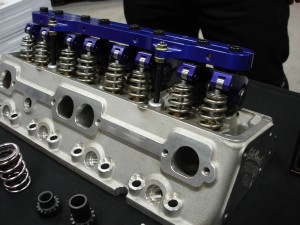
Valvetrain Durability
Regardless of what type of valve springs, pushrods or rockers are used in an engine, durability is an essential consideration when selecting and matching valvetrain components. Street performance engines are expected to go tens of thousands of miles without having to replace anything. Endurance engines are expected to finish the race without breaking anything. Both types of applications require parts that are strong enough to go the distance. Lightweight valvetrain components are always a plus, but they don’t have to be as light as those in a high revving drag or circle track engine.
With diesel engines, durability is equally important. Most diesels are low revving engines, even highly modified ones for tractor and truck pulling. Even so, minimizing valvetrain weight while maximizing strength and rigidity is always a plus for valvetrain dynamics.
Aluminum roller rockers can be just as beneficial in a diesel engine as a gasoline engine.
Aluminum rockers reduce weight and friction while providing added strength and durability over many stock rockers. Pushrods should have a wall thickness of .080 inches or greater to minimize flexing. Slightly stiffer valve springs can also improve valvetrain dynamics while increasing a street engine’s RPM potential. These don’t have to be race parts, just good quality performance parts that are better than the stock parts they replace.
Cost is another factor that determines what kind of parts ultimately go into an engine’s upper valvetrain. A lot of racers would love to have super light titanium valves, extra strong billet steel shaft-mounted rockers and oversized tool steel pushrods in their engines, but can’t afford them — or the rules don’t allow such parts. Truth is, many racers don’t really need such exotic and expensive valvetrain components. What they actually need are pushrods, rockers and valve springs that are appropriate for the kind of racing they do.
Take rocker arms, for example. Rockers run the gambit from mass produced entry level “budget” rockers to CNC machined custom race only rockers. For dirt tracks that require stock appearing stamped steel ball stud rockers, one can always upgrade to stamped steel rockers that are made of stronger more durable alloys. If there are no rule restrictions, then the next step up would be to go with some type of aluminum roller rockers that offer lighter weight, reduced friction and better durability.
Aluminum rockers with roller bearing trunions and roller tips will typically produce some mild horsepower gains with no other modifications. It’s only a few horsepower in many cases, but nonetheless an improvement over stock. If the rockers have a higher lift ratio than the stock rockers they replace, additional power gains should be realized by opening and closing the valves at a faster rate and increasing overall lift.
Many rocker arm manufacturers offer “good,” “better” and “best” versions of their rockers in their product line. Some companies are better known for their mass market value-priced rockers while others specialize in race only rockers. It doesn’t matter who makes the rockers as long as they meet the needs of the engine your are building.
The entry level “good” rockers are typically cast aluminum roller rockers. They offer reduced weight, better stability and increased strength and durability over stock ball stud stamped rockers. These are not race rockers and will not hold up under those kind of conditions. But for many performance applications, they are perfectly adequate and provide good value for the money.
The next step up is the “better” rockers which are usually made from extruded aluminum. Extruded aluminum is stronger than cast aluminum, and reduces the risk of cracking failure due to porosity. Extruded aluminum rockers may or may not be slightly lighter or heavier than the cast variety depending on the design features of the rocker. Extruded rockers are better for higher revving engines and higher spring pressures.
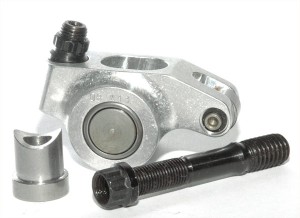
The design of the needle bearings in better rockers will also vary, with larger needles and/or tougher alloys being used to improve strength and wear resistance. Some rockers have gotten away from needle bearings altogether and use a bronze bushing as the pivot for the rocker. Spreading the load across the larger surface of a bushing rather than individual needle bearings improves durability according to those who make this type of rocker.
The “best” performance rockers may also be extruded aluminum, CNC machined billet aluminum or forged steel. Steel is obviously a heavier metal than aluminum, but it is also stronger. This allows the rockers to be designed in such as way as to minimize weight in areas where it isn’t needed. The end result can be a steel rocker that is nearly as light as an aluminum rocker, but with superior strength and durability for the most demanding racing applications.
NASCAR loves steel rockers. Virtually every team uses them in their engines. Steel rockers are the best choice for NASCAR racing because of the high engine speeds (up to 9,500 RPM) and length of the race. Steel rockers provide an extra margin of durability on the exhaust valves because it takes more oomph to push open exhaust valves against combustion pressure inside the cylinders. That also makes steel rockers a good choice for supercharged and turbocharged engines as well as those boosted with nitrous oxide.
Shaft mounted rockers are the hot setup for cylinder heads that can be fitted with a shaft rocker system. Although expensive, a shaft mounted rocker system offers the best valvetrain dynamics, stability, strength and reliability.
According to some manufacturers, changing from stud mounted rockers to shaft mounted rockers (using the same lift ratio as before) will typically produce 10 to 15 more horsepower thanks to increased valvetrain stability.
A shaft rocker system holds the rockers in better alignment, eliminating the need for a separate guide plate for the pushrods. This reduces flex in the valvetrain at higher speeds for better valve control. A pressed in stud for a ball and stamped steel rocker can deflect .005 inches or more as the valve opens and closes. This, in turn, can cause unwanted changes in valve lift and duration that hurt engine performance.
Screw-in oversized rocker studs are better, but can still deflect. Using longer rocker studs with a transverse stud girdle clamped around each stud improves rigidity over unsupported studs, but is still not as still as a shaft rocker system.
Another advantage with a shaft rocker system is better lubrication of the rockers. Oil can be routed through the shaft to supply each rocker individually. There is also less risk of breaking a rocker with a shaft mounted system because there are no slots cut in the bottom of the rockers to accommodate a stud.
Bolt-on shaft rocker systems are available for many heads where the valves are in a row. But on a BB Chevy or similar head where the valves are not in a row, a pedestal mount system can provide many of the same benefits as a shaft-mounted rocker system but at less cost.
The most important point to remember from this article is that valvetrains are a system. The individual parts have to be matched to each other and work together to achieve the desired results. They don’t have to be the most expensive parts, but they do have to be the “right” parts for the application.
Mismatched parts can limit power, bend, break and lose races. The right parts can allow an engine to develop its peak performance potential and win races.
If you’re uncertain as to which parts are the right parts for a given application, ask your camshaft and valvetrain component suppliers for their recommendations.
They make the parts and know which ones should be used together in the valvetrain system to achieve the desired results.

